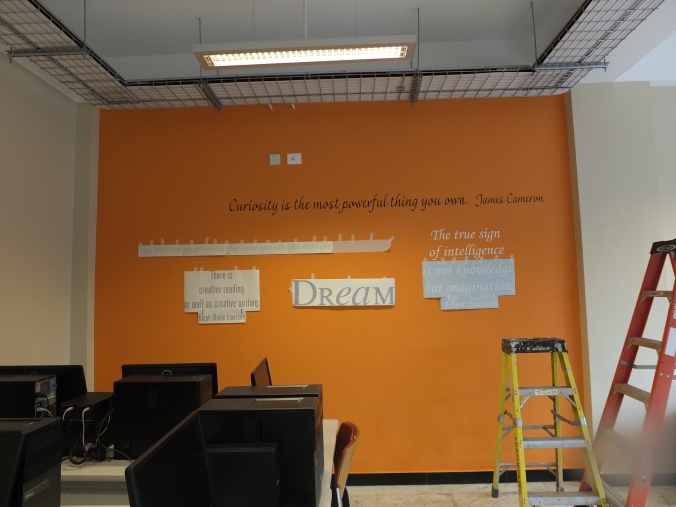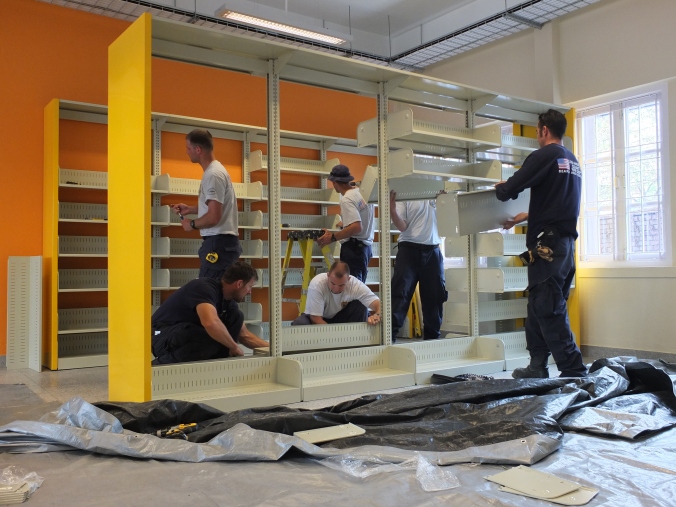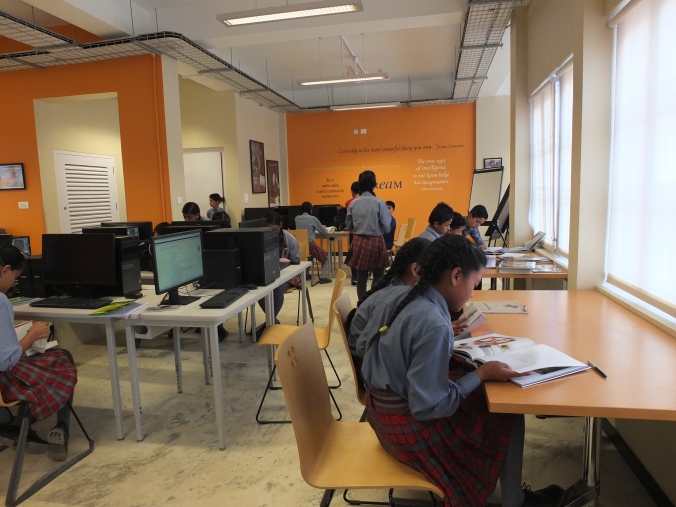This week’s Weekly Photo Challenge is Close Up, an opportunity to get close up and personal with your subject. In Chitwan I loved the chance to get up close to animals that I had only seen before in zoos.
Month: July 2015
The Library
The last story I have out of Nepal (at least for now) is my biggest tale, at least in terms of my focus and efforts over the last year. The U.S. State Department has opened American libraries all over the world and Nepal we already had about six, plus the Book Bus and a seventh library inside the U.S. Embassy in Kathmandu. But that space is small and security is tight, and the potential was there for a second Kathmandu site that could handle more outreach programs and deliver books to underserved communities on the other side of the city. As it turned out the timing of the opening was better than planned, as it came at a time when the few libraries that exist in the city were devastated by the earthquake.
Public libraries in Nepal are rare. Most schools don’t have them either, or only have a small selection of text books that are kept under lock and key. Lending libraries are even rarer. The plan to lend books out from the new space was often met with incredulity as people simply couldn’t believe that anyone would ever return them. Nepal libraries are usually reference centers and still only about books. American Spaces are more multi-media center with computers and electronic resources and, although Nepal mainstream is not really ready for new technology, the need is growing, and the new Innovation Hub will be at the forefront. Its very exciting, I’m just sad that I won’t be in Nepal to see it grow. It was a fantastic project opportunity, which was challenging to handle as it was educational for me, as I’m not a librarian. With the help of a small army–and despite a major earthquake– I managed to open it before I left. I’ll be keeping an enthusiastic online eye on its growth!

The earthquake-wrecked library at Tribuhavan University. Very Sad. None of the bookshelves were bolted down.

The original space before we started: Books covered with quilts of dust; broken shelving units; old paper card index systems; spider-web covered windows. This corner also had termites.

As the space opened up, the windows started to become more of a focus. They gave great light and the promise of a bright, open space.

After the electricans had finished, we started to focus on a colour scheme. Custom built furniture was erroneously delivered two months early and had to be removed – that was fun!

Eventually we picked orange for its energy and freshness. Along with the excellent light, it made the space very cheery and welcoming.

This was the condition of the custom built vinyl seat as delivered to me. Not the blue I selected, not the Formica I selected, and covered in dust from sitting around in the factory. It was a very frustrating experience.

Ditto with the circulation desk. I took this photo to show just how awful it looked when it was delivered. The formica was chipped and scratched and the whole thing was filthy. There is no recourse. So often there is just no understanding of quality standards – a very challenging part of the project.

I kept this picture just for the irony. Termites kept invading the library in new spots. I took this photo the day before the earthquake and the next morning a pest control guy arrived with the poison. Two hours later we had a lot more than termites to worry about.

…which I was actually doing when the earthquake struck. Carpenters were in the middle of assembling metal shelves when they had to run out of the building. The bookcases were not yet bolted down and swayed dangerously next to my ladder.

Shelving crashed down everywhere except where I stood on the ladder. I was very lucky. For two weeks, the bookshelves lay where they fell alongside the unassembled units on the floor. Finally I got help from the USAID Disaster And Rescue Team (DART) who were still in Nepal but with no longer anyone left to rescue from the quake, they came to my aid instead.

A group photo at the end of a job well done. I was so grateful for their help! With the shelves completed the library team could move in with books and start to turn it into a real library

Showing teachers and students around, explaining what the library does and how patrons would be able to borrow books – a pretty new concept for Nepal.
After the Quake – Part 3
I spent most of my last year in Nepal opening a library. (Post to come on that one.) I would arrive at the building in Teku every week for months and would always notice three Hindu temple towers in the near distance. I had no idea what to expect, but wanted to find some time to go over and explore. It was just a few minutes walk away, but work schedules never allowed the time until one weekend –prior to the earthquake– I supervised a cleaning crew before our soft opening. At lunch time the crew headed out to get something to eat, and Kalpana and I went out to explore. Partnered with a Nepali, I got a little braver at snooping around. We struggled at first to find a way in through the locked gate, but we learnt that entrance was long forgotten and another path took us into the heart of the temple. It was a fascinating combination of cared for and unkempt, and clearly was in need of funds for renovation. The main temple was boxed in by traditional out houses, laid in a square. I’ve seen them used as meeting halls, schools and storage spaces. Covered verandas were piled high with old carved beams, stone cornerstones and salvaged religious artifacts. Dog sat caged and barking in one corner and we watched chickens run around in another.
Outside the main temple, lanes ran off to the right and left. Overgrown paths led to dirt tracks. Exploring further, we pushed open gates blocked by weeds or broken hinges and what we found was an amazing labyrinth of temples – small and large, ramshackle homes with laundry hanging outside, and inhabited homes and forgotten buildings…all jumbled together. Some buildings were so tenuously standing that they appears to held together with just one beam. It was like a secret, forgotten place.
Among all of this were signs written in Nepali. I asked Kalpana what they said. “They’re donations”, she said. “People donated money. But I don’t understand. Where did all the money go?”
It did seem extraordinary that such a significant site that was clearly of important religious significance had been left to such extensive neglect. Anywhere else in the developed world it would be repaired, groomed and open to the public, the gardens would be kept and visitors would stroll through them with a guide, and locals would sell coffee and trinkets to the tourists. But here the site sat lonely and unnoticed, just five minutes walk away from every day life.

The surrounding courtyard buildings of Tin Deval housed salvaged artifacts, kenneled dogs and chickens. At least half of these buildings are now piles of rubble.

…and after. How precarious that middle cap looks! How unsalvagable with no crane or equipment! It’s doomed to break.

After the second quake. The third temple was clearly damaged also. These were taken down before they fell.
Even though I was in Teku daily during my last month in Nepal, opening the library to the public, I never went back to the site. It was just too scary. The aftershocks meant that it was foolish to wander around in ruins. There was nowhere safe to run. A part of me didn’t want to see extensive damage to a site that I knew would never receive the funding attention that Kathmandu’s famous squares will receive, but I would have gone in the end…just out of respect. I am sure very much of it is gone and it won’t be recovered. I am so glad I at least got to take photos and have captured a little of it here.
WPC: Fat Betty
This week’s Photo Challenge Half and Half asks us to share an image that represents two clear halves, literally or figuratively. Meet Fat Betty. She stands on the Coast to Coast walk in Northern England, on the bleak road that leads across the North York moors from Blakey Rigg to Rosedale Abbey. The head of the cross is an ancient wheelhead half-painted white.
Out on the moors it just you, the brooding sky and the purple heather that stretches out for miles ahead. I thought Fat Betty made an interesting contrast to the already bisected vista, at least until the fog comes down and everything disappears.
After the Quake – Part 2
About two weeks after the second quake, I was back in the Kathmandu Dhurba Square neighbourhood searching for a vacuum cleaner of all things… I wasn’t having much success as most of the stores were still closed, as many of the store owners had returned to their villages to help with the recovery. We were about to head back to work when, on a whim, we decided to stop and take a look for ourselves at the devastation that happened at this famous World Heritage site.
It was eerie. A lane had been roped for pedestrians to walk though the main site, keeping us away from the damaged buildings. Walking past piles of sorted rubble, tents, and cracked buildings, all we could really do was stare in horror. The palace roof was severely damaged, whole temples had completely disappeared and tourist vendors were gone and had been replaced by a tent village. It really looked nothing like its former self. For contrast, take a look at the short video I made just a couple of months before the earthquake. Here also are a few pictures:

After the quake and after the rescue squads, in came the clean up crew and stacked the wooden beams and want ever was salvageable from the wreckage (not much). The rest of us just stood and gawped.

Where tourist vendors previously set up endless stands of Nepalese tourist paraphernalia, now sprung a tent city.
I think international money will come in and rebuild the three Dhurba squares (Kathmandu, Patan and Bhaktapur). However, outside of the World Heritage Sites, so much has been destroyed that will never be replaced. I hope what is rebuilt has a little seismic resilience built into the construction next time around.
After the Quake – Part 1
Its not often that you see a city take shape before your eyes. Manila was that way, with giant skyscrapers flying up seemingly overnight. By contrast, Kathmandu builders took years to put up a couple of much smaller multi-story buildings in our neighbourhood. Since the earthquake, the Nepali government stopped the construction of high-rise buildings in Kathmandu. A significant number received a yellow or red card from earthquake damage and the skills and technology needed to implode them are absent along with any conviction to uphold seismic code regulations. What Kathmandu excels in is the construction of two and three story apartment buildings on what was used to be rice paddies. They fly up in the blink of an eye. There’s no seismic code implementation there either, but luckily many did survive the tremors.
Many older buildings didn’t, especially in the Narayan Chaur/ Nag Pokahari area which was walking distance from our home. Before the quake, the neighborhood was a typical mixture of old and new, but it felt poised to grow, gentrify even. Recent community efforts to upgrade communal spaces with simple outdoor activities and “beautification” efforts continued long after the recent SAARC efforts to spruce up the city. Narayan Chaur, an oval-shaped piece of open land in Naxal, was largely a waste ground and dumping site when we first arrived in Kathmandu. With what in retrospect was surprising foresight, the community police in Naxal developed the barren land into a park and possible rescue point in times of natural calamity. The land was fenced off and a footpath laid out around the perimeter. For a while it turned into a favourite exercise spot for early morning joggers. Clearly, the value to the community was enormous in a city with no parks. Its was a roaring success.
After the quake, Narayan Chaur, quickly became a tent city. I spent about six hours there immediately after the earthquake, sheltering in one of the few, relatively safe open spaces, as the after tremors kept coming and coming. I finally left to walk home, but others are still living there now, almost three months later.
Nearby so many old buildings were destroyed. Some were ready to fall anyway, others just ramshackle from years of neglect. I could already see that it was just a matter of time before the old buildings were demolished to be replaced by new, but the hope persisted that perhaps they would survive long enough for someone to come save them. But the earthquake took care of them in its own way, and now there’s little evidence they even existed.

Before the quake, the ramshackle temple at Nag Pokhari housed a school also. Its almost dilapidated buildings showed wonderful traditional architecture and carving.
Crisis. What Crisis?
The contrast between the Nepal I left and the Greece I find myself in couldn’t be more stark, although the journey has been from one crisis to another. As I left Kathmandu, the city was settling back to its old chaotic self with record traffic and loadshedding a-plenty. The schools had returned, a demolition effort had removed the more visible damage, and remaining remnants from the earthquake’s devastation just blended together with the old, broken, and partially-constructed ramshackleness of the pre-earthquake city. At least on the surface, things looked back to normal.
Here –at least superficially — there is no crisis in sight. The air smells of Greek pine-y fragrance, the crickets are making their usual racket, the July sun beats down and the cross winds blow through our house sending dried bougainvillea flowers scuttling down our path. I watch the sea sparkle and little boats chug by in the distance. Its peaceful, beautiful, and a wonderful place to be.
WPC: Nepalese Doors
This week’s Weekly Photo Challenge: Doors is an opportunity to feature Nepali doors – plain and ornate. I may have just left, but I think I’ve many a Nepali post still to come!





























